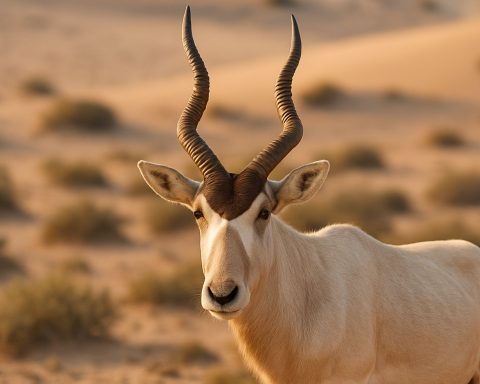Saving the Addax: Inside the Urgent Battle to Rescue the World’s Rarest Antelope. Discover the Strategies, Challenges, and Hope Driving Addax Antelope Conservation Efforts.
- Introduction: The Plight of the Addax Antelope
- Current Population Status and Distribution
- Major Threats Facing the Addax
- Conservation Strategies and Success Stories
- Role of Captive Breeding and Reintroduction Programs
- Community Involvement and Local Partnerships
- International Collaboration and Policy Initiatives
- Challenges and Barriers to Recovery
- Future Outlook: What’s Next for Addax Conservation?
- How You Can Help: Supporting Addax Survival
- Sources & References
Introduction: The Plight of the Addax Antelope
The addax antelope (Addax nasomaculatus), also known as the white antelope or screwhorn antelope, is a critically endangered species native to the Sahara Desert. Once widespread across North Africa, the addax has suffered catastrophic population declines due to a combination of overhunting, habitat loss, and the impacts of armed conflict and resource extraction in its range. Today, fewer than 100 individuals are estimated to survive in the wild, making the addax one of the world’s most imperiled large mammals. The International Union for Conservation of Nature (IUCN) lists the species as Critically Endangered, highlighting the urgent need for coordinated conservation action (International Union for Conservation of Nature).
The plight of the addax is emblematic of the broader challenges facing desert-adapted wildlife in the Sahel and Sahara regions. The species’ decline has been driven by unsustainable hunting for meat and horns, as well as habitat degradation from oil exploration, livestock grazing, and expanding human settlements. Climate change further exacerbates these threats by altering the fragile desert ecosystem on which the addax depends. Conservation efforts, including anti-poaching patrols, habitat protection, and captive breeding programs, are underway but face significant logistical and political obstacles. The survival of the addax now hinges on international collaboration and the effective implementation of science-based management strategies (Convention on the Conservation of Migratory Species of Wild Animals).
Current Population Status and Distribution
The addax antelope (Addax nasomaculatus), once widespread across the Sahara, is now classified as Critically Endangered, with wild populations at the brink of extinction. Recent field surveys and aerial counts indicate that fewer than 100 individuals remain in the wild, with some estimates suggesting numbers as low as 30–90. The last viable wild populations are primarily confined to the Termit & Tin Toumma region in Niger, with sporadic, unconfirmed sightings in Chad. The species’ range has contracted dramatically due to overhunting, habitat degradation, and competition with livestock, leaving only fragmented and isolated groups in remote desert areas International Union for Conservation of Nature (IUCN).
In addition to the wild population, there are several thousand addax in captivity and managed reserves worldwide. Notably, reintroduction programs in Tunisia and Morocco have established semi-wild populations within fenced reserves, contributing to the species’ survival but not yet restoring self-sustaining wild populations. The addax’s current distribution is thus highly restricted, with the species surviving in only a fraction of its historical range. Ongoing threats, including oil exploration and political instability in key habitats, continue to jeopardize the remaining wild herds Convention on the Conservation of Migratory Species of Wild Animals (CMS). Conservation efforts are urgently needed to stabilize and recover the wild addax population and to secure its remaining habitat.
Major Threats Facing the Addax
The addax antelope (Addax nasomaculatus) faces a critical risk of extinction, with fewer than 100 individuals estimated to remain in the wild. The most significant threat to the addax is illegal hunting, particularly by armed groups operating in remote desert regions. These groups target the addax for meat and trophies, exploiting the species’ vulnerability in its shrinking habitat. Habitat loss and degradation further exacerbate the situation, as oil exploration, infrastructure development, and expanding human settlements fragment and reduce the already limited range of the addax in the Sahara Desert. Overgrazing by domestic livestock also competes with the addax for scarce food resources, intensifying pressure on the population.
Climate change compounds these threats by increasing the frequency and severity of droughts, which diminish water and forage availability. The addax’s nomadic lifestyle, once an adaptation to the harsh desert environment, is now hindered by barriers such as roads and fences, restricting their movement and access to essential resources. Additionally, political instability in the region hampers effective conservation efforts, making it difficult to enforce anti-poaching laws and implement habitat protection measures. Without urgent and coordinated action, these combined threats could lead to the species’ extinction in the wild within the next decade International Union for Conservation of Nature, Convention on Migratory Species.
Conservation Strategies and Success Stories
Conservation strategies for the critically endangered addax antelope (Addax nasomaculatus) have evolved in response to the species’ dramatic decline, with fewer than 100 individuals estimated to remain in the wild. A cornerstone of these efforts is the establishment of protected areas, such as Niger’s Termit and Tin Toumma National Nature Reserve, which provides a sanctuary for the last wild populations. However, ongoing threats from poaching and habitat encroachment have necessitated more comprehensive approaches, including community engagement and transboundary cooperation. International organizations, such as the International Union for Conservation of Nature (IUCN), have played a pivotal role in coordinating action plans and monitoring population trends.
Ex situ conservation has also been instrumental. Captive breeding programs in zoos and wildlife reserves worldwide have maintained genetically diverse populations, serving as a genetic reservoir for potential reintroductions. Notably, the Sahara Conservation Fund has led successful reintroduction projects, releasing captive-bred addax into secure reserves in their native range. These initiatives have demonstrated that, with adequate protection and management, addax can adapt and thrive in the wild. Collaborative efforts between governments, NGOs, and local communities have further strengthened anti-poaching patrols and raised awareness about the species’ plight.
While challenges remain, these integrated conservation strategies offer hope. The addax’s story underscores the importance of combining in situ and ex situ measures, international collaboration, and local stewardship to prevent extinction and restore populations in the wild.
Role of Captive Breeding and Reintroduction Programs
Captive breeding and reintroduction programs have become pivotal strategies in the conservation of the critically endangered addax antelope (Addax nasomaculatus). With wild populations reduced to fewer than 100 individuals due to habitat loss, hunting, and political instability in their native Sahara, ex situ conservation efforts have provided a crucial lifeline. Zoos and specialized breeding centers across Europe, North America, and the Middle East maintain genetically managed populations, ensuring the preservation of the species’ genetic diversity and serving as a reservoir for future reintroductions (IUCN SSC Antelope Specialist Group).
Reintroduction initiatives, such as those in Tunisia’s national parks and reserves, have demonstrated that addax can adapt and breed successfully in semi-wild conditions. These programs involve careful selection of individuals based on genetic compatibility, health screening, and acclimatization to local environments before release. Post-release monitoring is essential to assess survival, reproduction, and integration with existing populations (Convention on Migratory Species).
Despite these successes, challenges remain. Reintroduced populations are vulnerable to poaching, disease, and environmental changes. Long-term viability depends on continued international collaboration, habitat protection, and community engagement. Nevertheless, captive breeding and reintroduction remain indispensable tools, offering hope for the recovery of the addax in its native range (European Association of Zoos and Aquaria).
Community Involvement and Local Partnerships
Community involvement and local partnerships are critical components in the conservation of the addax antelope (Addax nasomaculatus), a species now classified as Critically Endangered. The remaining wild populations of addax are found in remote regions of the Sahara, where local communities often have deep-rooted knowledge of the landscape and its wildlife. Conservation organizations increasingly recognize that the success of addax recovery efforts depends on the active participation and support of these communities.
Collaborative initiatives, such as those led by the Sahara Conservation Fund, focus on building trust and shared responsibility with local stakeholders. These programs provide education on the ecological importance of the addax, promote sustainable land use practices, and offer alternative livelihoods to reduce reliance on activities that threaten the species, such as poaching and overgrazing. In Niger, for example, partnerships with nomadic pastoralists have led to the establishment of community-managed reserves and anti-poaching patrols, which have proven effective in protecting both the addax and its habitat.
Furthermore, local partnerships facilitate the integration of traditional ecological knowledge into conservation planning, ensuring that strategies are culturally appropriate and more likely to be embraced by the community. International agencies, such as the International Union for Conservation of Nature (IUCN), emphasize that empowering local people not only enhances the protection of the addax but also contributes to broader goals of sustainable development and biodiversity conservation.
International Collaboration and Policy Initiatives
International collaboration and policy initiatives are pivotal in the conservation of the critically endangered addax antelope (Addax nasomaculatus). With wild populations now numbering fewer than 100 individuals, primarily in Niger, transboundary cooperation and robust policy frameworks are essential to prevent extinction. Multinational agreements, such as the Convention on International Trade in Endangered Species of Wild Fauna and Flora (CITES), regulate trade and provide a legal basis for protection, while the Convention on Migratory Species (CMS) facilitates coordinated action across the addax’s historical range.
Regional partnerships, such as the Sahelo-Saharan Interest Group, bring together governments, NGOs, and research institutions to share data, harmonize anti-poaching efforts, and develop joint management plans. International funding and technical support from organizations like the International Union for Conservation of Nature (IUCN) and the Zoological Society of London (ZSL) have enabled critical field surveys, genetic studies, and the establishment of protected areas. Furthermore, ex situ conservation programs, including captive breeding and reintroduction initiatives, are coordinated globally through the European Association of Zoos and Aquaria (EAZA) and the Association of Zoos and Aquariums (AZA).
Despite these efforts, challenges remain, including political instability, limited resources, and the need for stronger enforcement of existing policies. Continued international collaboration, adaptive management, and sustained policy commitment are vital to secure the future of the addax antelope in the wild.
Challenges and Barriers to Recovery
The conservation of the critically endangered addax antelope faces numerous challenges and barriers that hinder recovery efforts. One of the most significant threats is habitat loss, primarily due to oil exploration, infrastructure development, and expanding agriculture in the Sahara and Sahel regions. These activities fragment the addax’s already limited range, reducing access to essential resources and increasing vulnerability to environmental changes. Additionally, illegal hunting for meat and horns continues to decimate wild populations, despite legal protections and international agreements such as CITES (CITES).
Political instability and conflict in key range states, including Niger and Chad, further complicate conservation efforts. These conditions limit the ability of conservation organizations and government agencies to monitor populations, enforce anti-poaching laws, and implement recovery programs. Moreover, the remoteness and harshness of the addax’s desert habitat make fieldwork logistically challenging and costly, restricting the frequency and scope of scientific surveys (International Union for Conservation of Nature).
Another barrier is the limited genetic diversity of the remaining wild and captive populations, which raises concerns about inbreeding and long-term viability. While ex situ breeding programs exist, reintroduction efforts are hampered by the lack of secure, well-managed habitats and ongoing threats in the wild. Addressing these multifaceted challenges requires sustained international collaboration, adequate funding, and the integration of local communities into conservation strategies (Convention on Migratory Species).
Future Outlook: What’s Next for Addax Conservation?
The future of addax antelope conservation hinges on a combination of intensified in situ and ex situ efforts, international collaboration, and adaptive management strategies. With fewer than 100 individuals estimated to remain in the wild, primarily in Niger’s Termit & Tin Toumma region, the species faces imminent extinction without urgent intervention. Key priorities include strengthening anti-poaching patrols, expanding protected areas, and fostering community engagement to mitigate human-wildlife conflict and habitat degradation.
Ex situ conservation, particularly captive breeding programs, will continue to play a pivotal role. Institutions such as International Union for Conservation of Nature (IUCN) and European Association of Zoos and Aquaria (EAZA) are coordinating global studbooks and reintroduction initiatives, aiming to bolster wild populations with genetically diverse individuals. However, successful reintroduction depends on securing and restoring suitable habitats, as well as ensuring long-term political stability in range countries.
Emerging technologies, such as satellite tracking and genetic monitoring, offer new tools for monitoring populations and guiding management decisions. International funding and policy support, including the enforcement of CITES regulations, remain critical for sustaining conservation momentum. Ultimately, the outlook for the addax will depend on sustained commitment from governments, NGOs, and local communities, as well as the ability to adapt strategies in response to evolving threats and opportunities. If these efforts are maintained and scaled, there is cautious optimism that the addax can be brought back from the brink of extinction.
How You Can Help: Supporting Addax Survival
Individuals and organizations can play a crucial role in supporting the survival of the critically endangered addax antelope. One of the most effective ways to contribute is by supporting reputable conservation organizations actively engaged in addax protection, such as the International Union for Conservation of Nature (IUCN) and the Sahara Conservation Fund. Donations to these groups help fund anti-poaching patrols, habitat restoration, and scientific research essential for the species’ recovery.
Raising awareness is another powerful tool. Sharing information about the addax’s plight through social media, community events, or educational programs can increase public support and pressure governments to prioritize conservation efforts. Advocating for stronger legal protections and sustainable land management policies in the Sahel and Sahara regions can also make a significant difference.
For those interested in hands-on involvement, volunteering with conservation projects or participating in citizen science initiatives can provide direct support. Additionally, responsible tourism—choosing eco-friendly operators and respecting wildlife guidelines—can generate income for local communities while promoting the value of living addax populations.
Finally, supporting global efforts to combat climate change and desertification indirectly benefits the addax by preserving its fragile desert habitat. Every action, from reducing personal carbon footprints to supporting international environmental agreements, contributes to a safer future for the addax antelope. For more information on how to get involved, visit the World Wildlife Fund.
Sources & References
- International Union for Conservation of Nature
- Convention on the Conservation of Migratory Species of Wild Animals
- International Union for Conservation of Nature (IUCN)
- European Association of Zoos and Aquaria
- Association of Zoos and Aquariums (AZA)















